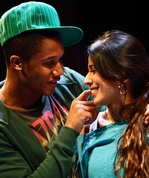SITE GUIDE
SEARCH
REVIEWS
REVIEW ARCHIVES
ADVERTISING AT CURTAINUP
FEATURES
NEWS
Etcetera and
Short Term Listings
LISTINGS
Broadway
Off-Broadway
NYC Restaurants
BOOKS and CDs
OTHER PLACES
Berkshires
London
California
New Jersey
DC
Connecticut
Philadelphia
Elsewhere
QUOTES
TKTS
PLAYWRIGHTS' ALBUMS
LETTERS TO EDITOR
FILM
LINKS
MISCELLANEOUS
Free Updates
Masthead
Writing for Us
A CurtainUp  London Review
London Review
 London Review
London ReviewWhat Fatima Did . . .
|
My grandmother fought for my mother not to wear it. My mother fought for me.— Rukshana, Fatima's mother
|

Simon Coombs as Craig and Farzana Dua Elahe as Aisha (Photo: Alex Rumford ) |
The actors themselves are a diverse group of first generation British, children of immigrant parents. Arsher Ali plays Mohammed Fatima's twin brother and Shobu Kapoor is Rukshana their mother. Simon Coombs is Craig of Caribbean origins and butt of much of the laughter is Afro Caribbean Stacey (Bunmi Mojekwu). George (Gethin Anthony) is white, Irish and Fatima's boyfriend in her pre-hijab days. Farzana Dua Elahe is an Asian girl, as modern as Fatima used to be. The teacher Ms Harris (Catherine Cusack) is married to an Iranian and has her own experiences of compulsory dress for women.
The repartee between the class mates is fast and funny. They mimic every other immigrant accent mercilessly as they describe the citizenship ceremony one of them has witnessed. Fatima was a fun loving partying girl who smokes and drinks and suddenly just before her eighteenth birthday she takes to wearing a black headscarf and everyone is left around waiting for her to show up. "She's turned into a ninja!" Stacey tells the class. Fatima's mother is horrified. She tells her son that she would rather Fatima was a one legged prostitute than a hijab wearer.
There is a build up where Fatima and her motives are discussed by everybody but we never really hear her motives for the change of dress. Mohammed makes an impassioned speech about how Muslims are hated, how if he wears a backpack on the underground everyone will move away from him in case there is a bomb in the bag.
Atiha Sen Gupta has cleverly brought everyone else's ideas and prejudices about Fatima to the fore but the most powerful scene of the play is not the comic repartee among the kids but the mother's impassioned speech about how she and her mother resisted wearing the hijab. One theory is that the recent trend of Muslim girls dressing more conservatively than their parents is a youth rebellion, grasping at something that their parents do not approve of and something which they can believe in and which is just theirs.
The performances are uniformly believable but the play is rather over extended. The schoolroom set conveys old desks, hard chairs and tall grey brick walls, anonymous, brutal and of the inner city. This is a promising beginning for a new playwright with a good choice of subject.
|
Subscribe to our FREE email updates with a note from editor Elyse Sommer about additions to the website -- with main page hot links to the latest features posted at our numerous locations. To subscribe,
E-mail: esommer@curtainup.comesommer@curtainup.com
put SUBSCRIBE CURTAINUP EMAIL UPDATE in the subject line and your full name and email address in the body of the message -- if you can spare a minute, tell us how you came to CurtainUp and from what part of the country. |
| What Fatima Did . . .
Written by Atiha Sen Gupta Directed by Kelly Wilkinson With: Simon Coombs, Gethin Anthony, Bunmi Mojekwu, Arsher Ali, Farzana Dua Elahe, Csatherine Cusack, Shobu Kapoor Design: Becky Gunstone Lighting: Natasha Chivers Sound: Sarah Weltman Running time: One and three quarter hours with no interval Box Office: Booking to 7th November 2009 Reviewed by Lizzie Loveridge based on 27th October 2009 performance at the Hampstead Theatre, Eton Avenue, NW3 (Tube: Swiss Cottage) |
|
REVIEW FEEDBACK Highlight one of the responses below and click "copy" or"CTRL+C"
Paste the highlighted text into the subject line (CTRL+ V): Feel free to add detailed comments in the body of the email . . . also the names and emails of any friends to whom you'd like us to forward a copy of this review. |
|
London Theatre Tickets Lion King Tickets Billy Elliot Tickets Mighty Boosh Tickets Mamma Mia Tickets We Will Rock You Tickets Theatre Tickets |




